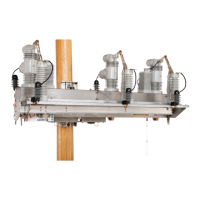Use Verbose Diagnostic DNP Logging
When the Enabled setting is selected (for diagnosing a communication issue), a message
is logged for every source and destination frame. Enabling this function for an extended
period will cause historic logs to ll quickly and reduce the number of saved historical
events. The Disabled setting is the default.
DNP Application Layer Confirmations
When the Enabled setting is selected, an application layer conrmation will be requested
with every solicited response that includes event data. Event buffers will not be cleared
until an application layer conrmation is received from the master station. When disabled,
the event buffers are cleared when events are reported. The Enabled setting is the default.
This setting applies to all masters.
Maximum Transfer Unit
This setting allows the IntelliTeam SG system to make the most efficient use of
communication system bandwidth. For SpeedNet™ Radios, set it to 500. For an
Ethernet connection, set it to 1500. For other communication devices, set it to the
maximum packet size of the device. The Maximum Transfer Unit setpoint is only used for
IntelliTeam SG system communications and can be set to the default setting for any
control not using the IntelliTeam SG system. (Range: 205-2,048; Step: 1; Default: 500)
Note: When pushing Netlists using IntelliTeam Designer, an Maximum Transfer Unit
setting of 500 or higher is required.
Peer-to-Peer Interpacket Delay
Set this to zero, unless the IntelliTeam SG system is enabled. Interpacket delay improves
communication reliability between team members by adjusting the delay between
successive frames of a multi-frame P2P fragment. The Maximum Transfer Unit setting
dened for that control determines frame size. When data trafc is heavy, a peer’s receive
buffer may overow, and messages could be lost. This problem is usually noticed in a
direct P2P/UDP system. The Interpacket Delay setting increases the time a peer will
have to process received data. It is advisable to increase the receive buffers instead
of increasing the Interpacket Delay setting, which will create articial delays in the
communication system. (Range: 0.0-10.0; Step: 0.5; Default: 0.0)
Local DNP Time Offset
When the Disabled setting is selected, UTC time is applied to the DNP timestamps.
When a local time offset ranging from +14 hr. to -14 hr. in 15-minute increments has been
selected, the offset is applied to the UTC time to allow the DNP time stamp to be adjusted
to local time. The Disabled setting is the default.
TCP Keep-Alive Timer
Species the time between keep-alive messages as dened in the DNP Specication.
See Instruction Sheet 766-560, “IntelliRupter® PulseCloser® Fault Interrupter:
DNP Points List and Implementation.” This setting applies to all masters. (Range:
5-65,535; Step: 1; Default: 300)
S&C Instruction Sheet 766-530 147
Communication Setup

